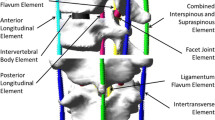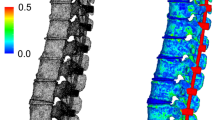Abstract
Purpose
Dynamic implants for the human spine are used to re-establish regular segmental motion. However, the results have often been unsatisfactory and complications such as screw loosening are common. Individualisation of appliances and precision implantation are needed to improve the outcome of this procedure. Computer simulation, virtual implant optimisation and image guidance were used to improve the technique.
Methods
A human lumbar spine computer model was developed using multi-body simulation software. The model simulates spinal motion under load and degenerative changes. After virtual degeneration of a L4/5 segment, virtual pedicle screw-based implants were introduced. The implants’ positions and properties were iteratively optimised. The resulting implant positions were used as operative plan for image guidance and finally implemented in a physical spine model.
Results
In the simulation, the introduction and optimisation of virtually designed dynamic implants could partly compensate for the effects of virtual lumbar segment degeneration. The optimised operative plan was exported to two different image-guidance systems for transfer to a physical spine model.
Conclusion
Three-dimensional computer graphic simulation is a feasible means to develop operative plans for dynamic spinal stabilization. These operative plans can be transferred to commercially available image-guidance systems for use in implantation of physical implants in a spine model. This concept has important potential in the design of operative plans and implants for individualised dynamic spine stabilization surgery.





Similar content being viewed by others
References
Bothmann M, Kast E, Boldt GJ, Oberle J (2008) Dynesys fixation for lumbar spine degeneration. Neurosurg Rev 31(2):189–196
Prud’homme M, Barrios C, Rouch P, Charles YP, Steib JP, Skalli W (2014) Clinical outcomes and complications after pedicle-anchored dynamic or hybrid lumbar spine stabilization: a systematic literature review. J Spinal Disord Tech. [Epub ahead of print]
Haher TR, Bergman M, O’Brien M, Felmly WT, Choueka J, Welin D, Chow G, Vassiliou A (1991) The effect of the three columns of the spine on the instantaneous axis of rotation in flexion and extension. Spine 16(8 Suppl):312–318
Niemeyer F, Wilke HJ, Schmidt H (2012) Geometry strongly influences the response of numerical models of the lumbar spine-a probabilistic finite element analysis. J Biomech 45(8):1414–1423
Galbusera F, Anasetti F, Bellini CM, Costa F, Fornari M (2010) The influence of the axial, antero-posterior and lateral positions of the center of rotation of a ball-and-socket disc prosthesis on the cervical spine biomechanics. Clin Biomech 25(5):397–401
Rohlmann A, Mann A, Zander T, Bergmann G (2009) Effect of an artificial disc on lumbar spine biomechanics: a probabilistic finite element study. Eur Spine J 18(1):89–97
Rohlmann A, Burra NK, Zander T, Bergmann G (2007) Comparison of the effects of bilateral posterior dynamic and rigid fixation devices on the loads in the lumbar spine: a finite element analysis. Eur Spine J 16(8):1223–1231
Tian NF, Huang QS, Zhou P, Zhou Y, Wu RK, Lou Y, Xu HZ (2011) Pedicle screw insertion accuracy with different assisted methods: a systematic review and meta-analysis of comparative studies. Eur Spine J 20(6):846–859
Gruber K, Ruder H, Denoth J, Schneider K (1998) A comparative study of impact dynamics: wobbling mass model versus rigid body models. J Biomech 31(5):439–444
Schmidt H, Galbusera F, Rohlmann A, Shirazi-Adl A (2013) What have we learned from finite element model studies of lumbar intervertebral discs in the past four decades? J Biomech 46(14):2342–2355
Zhang QH, Teo EC (2008) Finite element application in implant research for treatment of lumbar degenerative disc disease. Med Eng Phys 30(10):1246–1256
Lin HM, Pan YN, Liu CL, Huang LY, Huang CH, Chen CS (2013) Biomechanical comparison of the K-ROD and Dynesys dynamic spinal fixator systems—a finite element analysis. Biomed Mater Eng 23(6):495–505
Nolden M, Zelzer S, Seitel A, Wald D, Müller M, Franz AM, Maleike D, Fangerau M, Baumhauer M, Maier-Hein L, Maier-Hein KH, Meinzer HP, Wolf I (2013) The medical imaging interaction toolkit: challenges and advances. Int J Comput Assist Radiol Surg 8(4):607–620
Heuer F, Schmidt H, Klezl Z, Claes L, Wilke HJ (2007) Stepwise reduction of functional spinal structures increase range of motion and change lordosis angle. J Biomech 40(2):271–280
White AA, Panjabi MM (1991) Clinical biomechanics of the spine (2nd issue). Philadelphia, J.B., Lippincott Company
Hausen U, Bauer S, Gruber K (2012) Biomechanical effects of a spinal implant–investigation through MBS computer modelling. Biomed Tech (Berl) 57(Suppl 1):136–139
Schmölz W, Onder U, Martin A, von Strempel A (2009) Non-fusion instrumentation of the lumbar spine with a hinged pedicle screw system rod system: an in vitro experiment. Eur Spine J 18(10):1478–1485
Bauer S, Hausen U, Gruber K (2012) Effects of individual spine curvatures—a comparative study with the help of computer modelling. Biomed Tech (Berl) 57(Suppl 1):132–135
Natarajan RN, Andersson GB, Patwardhan AG, Andriacchi TP (1999) Study on effect of graded facetectomy on change in lumbar motion segment torsional flexibility using three- dimensional continuum contact representation for facet joints. J Biomech Eng 21(2):215–221
Rohlmann A, Zander T, Rao M, Bergmann G (2009) Realistic loading conditions for upper body bending. J Biomech 42(7):884–890
Hoag JM, Kosok M, Moser JR (1960) Kinematic analysis and classification of vertebral motion. J Am Osteopath Assoc 59:899–908
Kantelhardt SR, Martinez R, Baerwinkel S, Burger R, Giese A, Rohde V (2011) Perioperative course and accuracy of screw positioning in conventional, open robotic-guided and percutaneous robotic-guided, pedicle screw placement. Eur Spine J 20(6):860–868
Rizzi MA, Covelli B, Bivetti J, Lüthi B (1977) Biomechanics of vertebral segments. Clinical and prognostical interpretations. Arch Orthop Unfallchir 87(1):111–116
Reichmann S, Berglund E, Lundgren K (1972) The motion center in the lumbar spine during flexion and extension. Anat Entwicklungsgesch 138(3):283–287
Yoshioka T, Tsuji H, Hirano N, Sainoh S (1990) Motion characteristic of the normal lumbar spine in young adults: instantaneous axis of rotation and vertebral center motion analyses. J Spinal Disord 3(2):103–113
Pearcy MJ, Bogduk N (1988) Instantaneous axes of rotation of the lumbar intervertebral joints. Spine 13(9):1033–1041
Gertzbein SD, Holtby R, Tile M, Kapasouri A, Chan KW, Cruickshank B (1984) Determination of a locus of instantaneous centers of rotation of the lumbar disc by moiré fringes: a new technique. Spine 9(4):409–413
Takata Y, Matsuura T, Higashino K, Sakai T, Mishiro T, Suzue N, Kosaka H, Hamada D, Goto T, Nishisho T, Goda Y, Sato R, Tsutsui T, Tonogai I, Tezuka F, Mineta K, Kimura T, Nitta A, Higuchi T, Hama S, Sairyo K (2014) Hybrid technique of cortical bone trajectory and pedicle screwing for minimally invasive spine reconstruction surgery: a technical note. J Med Invest 61(3–4):388–392
Iwatsuki K, Yoshimine T, Ohnishi Y, Ninomiya K, Ohkawa T (2014) Isthmus-guided cortical bone trajectory for pedicle screw insertion. Orthop Surg 6(3):244–248
Kainmueller D, Lamecker H, Zachow S, Hege H-C (2009) An articulated statistical shape model for accurate hip joint segmentation. In: Proceedings of the18th annual international conference of the IEEE engineering in medicine and biology society (EMBC), Minneapolis, pp 6345–6351
Dworzak J, Lamecker H, von Berg J, Klinder T, Lorenz C, Kainmüller D, Seim H, Hege HC, Zachow S (2010) 3D reconstruction of the human rib cage from 2D projection images using a statistical shape model. Int J Comput Assist Radiol Surg 5(2):111–124
Conflict of interest
None.
Author information
Authors and Affiliations
Corresponding author
Rights and permissions
About this article
Cite this article
Kantelhardt, S.R., Hausen, U., Kosterhon, M. et al. Computer simulation and image guidance for individualised dynamic spinal stabilization. Int J CARS 10, 1325–1332 (2015). https://doi.org/10.1007/s11548-014-1138-1
Received:
Accepted:
Published:
Issue Date:
DOI: https://doi.org/10.1007/s11548-014-1138-1




